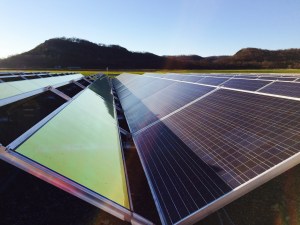
The following commentary was written by Jeff Cramer, president and CEO of the Coalition for Community Solar Access. See our commentary guidelines for more information.
For the first time since the epic War of the Currents between Thomas Edison and Nikola Tesla, we have a once-in-a-generation opportunity to rethink the grid.
In most of the U.S., our electric system is decades old and ill-prepared for the future. We’ve made huge strides nationally in clean energy technology, yet integration processes are outdated, leading to a bottleneck of enough generating capacity to power 247 million homes. Additionally, monopoly utilities naturally seek to limit new entrants and control how electricity is generated and delivered to customers.
The grid — and the electricity markets that support it — is limiting the innovation potential of competition and customer choice.
Earlier this year, however, initial guidance for major programs and tax credits under the Inflation Reduction Act was released, paving the way for a full decade of market certainty. Now is the time to empower state legislators and innovators to finally fix these problems and effectively democratize our energy system so everyone can benefit from the clean energy transformation — including all customers and energy resources large and small.
Sign up for Energy News Weekly
Get the most important energy news of the week delivered directly to your inbox.
Of all of the clean energy resources at our disposal, community solar is the most uniquely positioned to democratize the system by combatting both energy inequity and the overly centralized grid we face today.
While the boom in rooftop solar benefits some, more than two-thirds of American households and businesses are renters or do not have solar-friendly roofs, preventing them from accessing the benefits of local, clean energy. Community solar projects are located within a community where multiple customers can subscribe and receive credits on their utility bills for their share of the power that is produced, just as if the panels were on their own roofs. That means all customers — households, small and large businesses, schools, religious institutions, and hospitals — can participate in the clean energy transition by simply subscribing to a project in their service area.
Community solar may be our most formidable tool to provide equitable access to clean energy. Unlike utility-scale solar, which is owned by utilities and doesn’t directly benefit any specific customer class, and rooftop solar, which requires homeownership and financing, community solar can give all customers access to the benefits of solar energy with the same ease as signing up for a streaming service. Twenty-two states plus the District of Columbia now have policies that enable this type of solar, providing more than one million customers with access to local, clean electricity.
Building out community solar at scale yields substantial local economic benefits and, along with other smaller scale resources that are located closer to where energy is consumed, is also proven to make the grid more resilient and less expensive, especially when paired with battery storage. Research shows that a clean electric grid that better leverages smaller scale solar resources and storage alongside continued growth of large-scale renewables and transmission can save our grid tens of billions of dollars.
But to harness these new technologies and business models, it is state governments that must create the policies to capitalize on this make-or-break moment. What can state policymakers do?
First, learn from other states that have comprehensive energy plans to diversify their energy mix and meet their policy goals. Increasingly, states across the country are taking the lead to ensure diverse energy portfolios and choice in our system as we move to a cleaner grid. In New York, for example, Gov. Hochul’s administration, its state agencies, and the legislature have synchronized to make the Empire State the nation’s leader in community solar capacity and outlook with its 10 GW by 2030 Distributed Solar Roadmap. It’s one thing to make sweeping declarations, but quite another to align all bodies of government to ensure programs will come online and stay there. And in Wisconsin, conservative lawmakers are working to open a brand new community solar program, and bipartisan efforts to do the same in Michigan and Pennsylvania are also underway.
Second, for states that don’t have community solar policy in place, pass best-in-class enabling legislation that allows for a scalable program that opens the door to private investment and consumer choice while achieving a wide range of policy goals. If states already have a community solar program, begin the groundwork to align that program with federal incentives to grow your program and maximize the dollars available for distributed generation.
Third, take every opportunity to learn how state-level incentives can combine with new federal incentives to create force multipliers for investment. If unsure where to look for help, seek out stakeholder groups, like the National Association of State Energy Offices, and forums that are helping to implement the final framework of this federal guidance.
By following these steps, state policymakers can work effectively with IRA programs to lower barriers to solar access, create thousands of good paying jobs, and help transform the inefficient, centralized grid of the past into a decarbonized, cost-effective grid that is equitable, resilient, and works for all of us.
If we do this right, democratizing our energy system will mean giving customers true options about how and where their energy is generated. It will mean cutting red tape to give small power producers more access to our electric grid. And it will mean providing equitable access to clean energy and meaningful bill savings by harnessing innovative policies and technologies.
States can transform the grid to put people and small businesses first. This is how.



